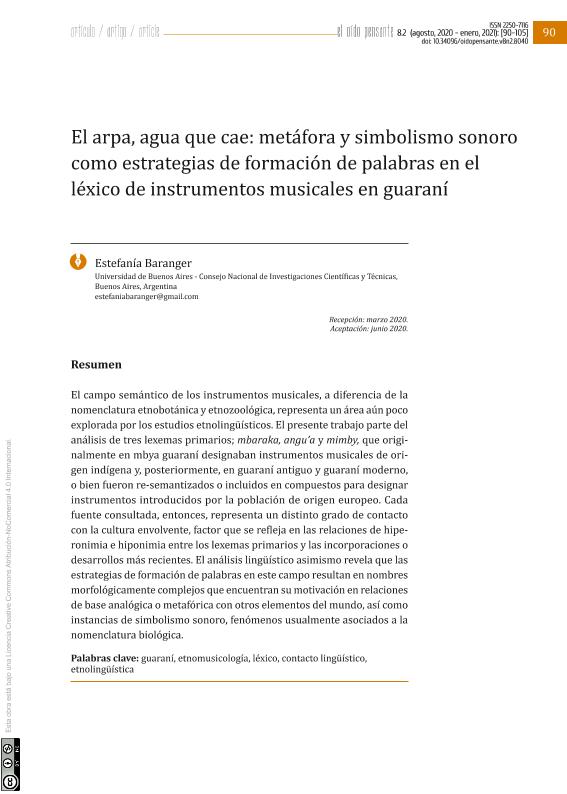Mostrar el registro sencillo del ítem
dc.contributor.author
Baranger, Estefania

dc.date.available
2022-10-20T15:39:12Z
dc.date.issued
2020-11
dc.identifier.citation
Baranger, Estefania; El arpa, agua que cae: Metáfora y simbolismo sonoro como estrategias de formación de palabras en el léxico de instrumentos musicales en guaraní; Universidad de Buenos Aires. Facultad de Filosofía y Letras. Instituto de Ciencias Antropológicas; El Oído Pensante; 8; 2; 11-2020; 90-105
dc.identifier.issn
2250-7116
dc.identifier.uri
http://hdl.handle.net/11336/174177
dc.description.abstract
El campo semántico de los instrumentos musicales, a diferencia de la nomenclatura etnobotánica y etnozoológica, representa un área aún poco explorada por los estudios etnolingüísticos. El presente trabajo parte del análisis de tres lexemas primarios; mbaraka, angu’a y mimby, que originalmente en mbya guaraní designaban instrumentos musicales de origen indígena y, posteriormente, en guaraní antiguo y guaraní moderno, o bien fueron re-semantizados o incluidos en compuestos para designar instrumentos introducidos por la población de origen europeo. Cada fuente consultada, entonces, representa un distinto grado de contacto con la cultura envolvente, factor que se refleja en las relaciones de hiperonimia e hiponimia entre los lexemas primarios y las incorporaciones o desarrollos más recientes. El análisis lingüístico asimismo revela que las estrategias de formación de palabras en este campo resultan en nombres morfológicamente complejos que encuentran su motivación en relaciones de base analógica o metafórica con otros elementos del mundo, así como instancias de simbolismo sonoro, fenómenos usualmente asociados a la nomenclatura biológica.
dc.description.abstract
The semantic field of musical instruments, unlike ethnobotanical and ethnozoological nomenclature, still represents an underexplored area in ethnolinguistic studies. The present work is based on the analysis of three primary lexemes; mbaraka, angu’a and mimby, which originally in Mbya Guarani designated musical instruments of indigenous origin and, later, in Old Guarani and Modern Guarani, were either re-semantisized or included in nominal compounds in order to designate instruments introduced by the population of European origin. Each source, then, represents a different degree of contact with the creole culture, a fact that is reflected in the hyponymy and hypernymy relations between these primary lexemes and the more recent incorporations or developments. Furthermore, this linguistic analysis reveals word-formation strategies in this field result in morphologically complex names motivated by metaphorical or analogical relations with other elements of the world, as well as instances of sound symbolism, phenomena which are usually associated with biological nomenclature.
dc.description.abstract
The semantic field of musical instruments, unlike ethnobotanical and ethnozoological nomenclature, still represents an underexplored area in ethnolinguistic studies. The present work is based on the analysis of three primary lexemes; mbaraka, angu’a and mimby, which originally in Mbya Guarani designated musical instruments of indigenous origin and, later, in Old Guarani and Modern Guarani, were either re-semantisized or included in nominal compounds in order to designate instruments introduced by the population of European origin. Each source, then, represents a different degree of contact with the creole culture, a fact that is reflected in the hyponymy and hypernymy relations between these primary lexemes and the more recent incorporations or developments. Furthermore, this linguistic analysis reveals word-formation strategies in this field result in morphologically complex names motivated by metaphorical or analogical relations with other elements of the world, as well as instances of sound symbolism, phenomena which are usually associated with biological nomenclature.
dc.format
application/pdf
dc.language.iso
spa
dc.publisher
Universidad de Buenos Aires. Facultad de Filosofía y Letras. Instituto de Ciencias Antropológicas
dc.rights
info:eu-repo/semantics/openAccess
dc.rights.uri
https://creativecommons.org/licenses/by-nc/2.5/ar/
dc.subject
ETHNOLINGUISTICS
dc.subject
ETHNOMUSICOLOGY
dc.subject
GUARANI
dc.subject
LEXICON
dc.subject
LINGUISTIC CONTACT
dc.subject.classification
Lingüística

dc.subject.classification
Lengua y Literatura

dc.subject.classification
HUMANIDADES

dc.title
El arpa, agua que cae: Metáfora y simbolismo sonoro como estrategias de formación de palabras en el léxico de instrumentos musicales en guaraní
dc.title
A harpa, água que cai: Metáfora e simbolismo sonoro como estratégias de formação de palavras no léxico de instrumentos musicais em Guarani
dc.title
The harp, a waterfall: Metaphor and sound symbolism as word-formation strategies in the musical instrument lexicon in Guarani
dc.type
info:eu-repo/semantics/article
dc.type
info:ar-repo/semantics/artículo
dc.type
info:eu-repo/semantics/publishedVersion
dc.date.updated
2022-10-03T17:55:01Z
dc.journal.volume
8
dc.journal.number
2
dc.journal.pagination
90-105
dc.journal.pais
Argentina

dc.journal.ciudad
Ciudad Autónoma de Buenos Aires
dc.description.fil
Fil: Baranger, Estefania. Universidad de Buenos Aires; Argentina. Consejo Nacional de Investigaciones Científicas y Técnicas. Centro Científico Tecnológico Conicet - Nordeste; Argentina
dc.journal.title
El Oído Pensante
dc.relation.alternativeid
info:eu-repo/semantics/altIdentifier/url/http://revistascientificas.filo.uba.ar/index.php/oidopensante/article/view/8040
dc.relation.alternativeid
info:eu-repo/semantics/altIdentifier/doi/http://dx.doi.org/10.34096/oidopensante.v8n2.8040
Archivos asociados
